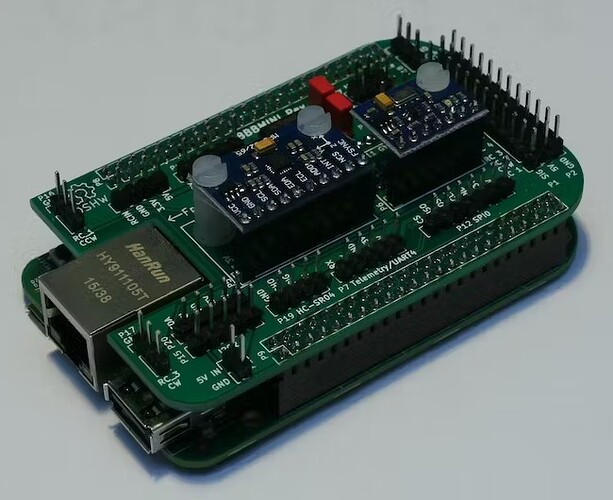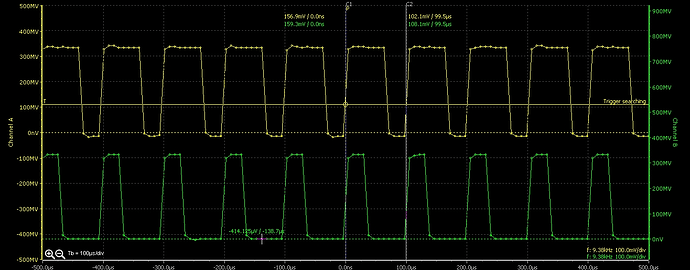Rover-4.4.0-beta1 has been released for beta testing and can be installed using MP or QGC’s beta firmwares link. Alternatively it can be manually downloaded from firmware.ardupilot.org.
The changes vs 4.3.0-beta12 are in the release notes and also copied below.
- New autopilots supported
- ESP32
- Flywoo Goku F405S AIO
- Foxeer H743v1
- MambaF405-2022B
- PixPilot-V3
- PixSurveyA2
- rFCU H743
- ThePeach K1/R1
- Autopilot specific changes
- Bi-Directional DShot support for CubeOrangePlus-bdshot, CUAVNora+, MatekF405TE/VTOL-bdshot, MatekL431, Pixhawk6C-bdshot, QioTekZealotH743-bdshot
- Bi-Directional DShot up to 8 channels on MatekH743
- BlueRobotics Navigator supports baro on I2C bus 6
- BMP280 baro only for BeastF7, KakuteF4, KakuteF7Mini, MambaF405, MatekF405, Omnibusf4 to reduce code size (aka “flash”)
- CSRF and Hott telemetry disabled by default on some low power boards (aka “minimised boards”)
- Foxeer Reaper F745 supports external compasses
- OmnibusF4 support for BMI270 IMU
- OmnibusF7V2-bdshot support removed
- KakuteF7 regains displayport, frees up DMA from unused serial port
- KakuteH7v2 gets second battery sensor
- MambaH743v4 supports VTX
- MatekF405-Wing supports InvensenseV3 IMUs
- PixPilot-V6 heater enabled
- Raspberry 64OS startup crash fixed
- ReaperF745AIO serial protocol defaults fixed
- SkystarsH7HD (non-bdshot) removed as users should always use -bdshot version
- Skyviper loses many unnecessary features to save flash
- UBlox GPS only for AtomRCF405NAVI, BeastF7, MatekF405, Omnibusf4 to reduce code size (aka “flash”)
- VRBrain-v52 and VRCore-v10 features reduced to save flash
- Driver enhancements
- ARK RTK GPS support
- BMI088 IMU filtering and timing improved, ignores bad data
- CRSF OSD may display disarmed state after flight mode (enabled using RC_OPTIONS)
- Daiwa winch baud rate obeys SERIALx_BAUD parameter
- EFI supports fuel pressure and ignition voltage reporting and battery failsafe
- ICM45686 IMU support
- ICM20602 uses fast reset instead of full reset on bad temperature sample (avoids occasional very high offset)
- ICM45686 supports fast sampling
- MAX31865 temp sensor support
- MB85RS256TY-32k, PB85RS128C and PB85RS2MC FRAM support
- MMC3416 compass orientation fix
- MPPT battery monitor reliability improvements, enable/disable aux function and less spammy
- Multiple USD-D1-CAN radar support
- NMEA output rate configurable (see NMEA_RATE_MS)
- NMEA output supports PASHR message (see NMEA_MSG_EN)
- OSD supports average resting cell voltage (see OSD_ACRVOLT_xxx params)
- Rockblock satellite modem support
- Serial baud support for 2Mbps (only some hardware supports this speed)
- SF45b lidar filtering reduced (allows detecting smaller obstacles
- SmartAudio 2.0 learns all VTX power levels)
- UAVCAN ESCs report error count using ESC Telemetry
- Unicore GPS (e.g. UM982) support
- VectorNav 100 external AHRS support
- 5 IMUs supported
- EKF related enhancements
- Baro compensation using wind estimates works when climbing or descending (see BAROx_WCF_UP/DN)
- External AHRS support for enabling only some sensors (e.g. IMU, Baro, Compass) see EAHRS_SENSORS
- Magnetic field tables updated
- Non-compass initial yaw alignment uses GPS course over GSF (mostly affects Planes and Rover)
- Control and navigation enhancements
- DO_SET_ROI_NONE command turns off ROI
- JUMP_TAG mission item support
- Manual mode steering expo configurable (see MANUAL_STR_EXPO)
- Missions can be stored on SD card (see BRD_SD_MISSION)
- NAV_SCRIPT_TIME command accepts floating point arguments
- Pause/Resume returns success if mission is already paused or resumed
- Camera and gimbal enhancements
- BMMCC support included in Servo driver
- DJI RS2/RS3-Pro gimbal support
- Dual camera support (see CAM2_TYPE)
- Gimbal/Mount2 can be moved to retracted or neutral position
- Gremsy ZIO support
- IMAGE_START_CAPTURE, SET_CAMERA_ZOOM/FOCUS, VIDEO_START/STOP_CAPTURE command support
- Paramters renamed and rescaled
- CAM_TRIGG_TYPE renamed to CAM1_TYPE and options have changed
- CAM_DURATION renamed to CAM1_DURATION and scaled in seconds
- CAM_FEEDBACK_PIN/POL renamed to CAM1_FEEBAK_PIN/POL
- CAM_MIN_INTERVAL renamed to CAM1_INTRVAL_MIN and scaled in seconds
- CAM_TRIGG_DIST renamed to CAMx_TRIGG_DIST and accepts fractional values
- RunCam2 4k support
- ViewPro camera gimbal support
- Logging changes
- BARD msg includes 3-axis dynamic pressure useful for baro compensation of wind estimate
- MCU log msg includes main CPU temp and voltage (was part of POWR message)
- RCOut banner message always included in Logs
- SCR message includes memory usage of all running scripts
- CANS message includes CAN bus tx/rx statistics
- Home location not logged to CMD message
- MOTB message includes throttle output
- Scripting enhancements
- EFI Skypower driver gets improved telem messages and bug fixes
- Generator throttle control example added
- Heap max increased by allowing heap to be split across multiple underlying OS heaps
- Hexsoon LEDs applet
- Logging from scripts supports more formats
- Parameters can be removed or reordered
- Parameter description support (scripts must be in AP’s applet or driver directory)
- Rangefinder driver support
- Runcam_on_arm applet starts recording when vehicle is armed
- Safety switch, E-Stop and motor interlock support
- Scripts can restart all scripts
- Script_Controller applet supports inflight switching of active scripts
- Custom build server enhancements
- AIS support for displaying nearby boats can be included
- Battery, Camera and Compass drivers can be included/excluded
- EKF3 wind estimation can be included/excluded
- PCA9685, ToshibaLED, PLAY_TUNE notify drivers can be included/excluded
- RichenPower generator can be included/excluded
- RC SRXL protocol can be excluded
- SIRF GPSs can be included/excluded
- Safety related enhancements and fixes
- Arming check for servo outputs skipped when SERVOx_FUNCTION is scripting
- Arming check fix if both “All” and other bitmasks are selected (previously only ran the other checks)
- GCS failsafe timeout is configurable (see FS_GCS_TIMEOUT)
- “EK3 sources require RangeFinder” pre-arm check fix when user only sets up 2nd rangefinder (e.g. 1st is disabled)
- Pre-arm check that low and critical battery failsafe thresholds are different
- Pre-arm message fixed if 2nd EKF core unhealthy
- Pre-arm check if reboot required to enabled IMU batch sampling (used for vibe analysis)
- RC failsafe timeout configurable (see RC_FS_TIMEOUT)
- Minor enhancements
- Boot time reduced by improving parameter conversion efficiency
- BRD_SAFETYENABLE parameter renamed to BRD_SAFETY_DEFLT
- Compass calibration auxiliary switch function (set RCx_OPTION=171)
- Disable IMU3 auxiliary switch function (set RCx_OPTION=110)
- Rangefinder and FS_OPTIONS param conversion code reduced (affects when upgrading from 3.6 or earlier)
- MAVFTP supports file renaming
- MAVLink in-progress reply to some requests for calibration from GCS
- Bug fixes:
- ADSB telemetry and callsign fixes
- Battery pct reported to GCS limited to 0% to 100% range
- Bi-directional DShot fix on H7 boards after system time wrap (more complete fix than in 4.3.6)
- DisplayPort OSD screen reliability improvement on heavily loaded OSDs especially F4 boards
- DisplayPort OSD artificial horizon better matches actual horizon
- EFI Serial MS bug fix to avoid possible infinite loop
- EKF3 Replay fix when COMPASS_LEARN=3
- ESC Telemetry external temp reporting fix
- Fence upload works even if Auto mode is excluded from firmware
- FMT messages logged even when Fence is exncluded from firmware (e.g. unselected when using custom build server)
- Hardfault avoided if user changes INS_LOG_BAT_CNT while batch sampling running
- ICM20649 temp sensor tolerate increased to avoid unnecessary FIFO reset
- IMU detection bug fix to avoid duplicates
- IMU temp cal fix when using auxiliary IMU
- Message Interval fix for restoring default rate GCS_MAVLink: fix set-default-rate of a message we don't send by default by peterbarker · Pull Request #21947 · ArduPilot/ardupilot · GitHub
- RADIO_STATUS messages slow-down feature never completely stops messages from being sent
- SERVOx_TRIM value output momentarily if SERVOx_FUNCTION is changed from Disabled to RCPassThru, RCIN1, etc. Avoids momentary divide-by-zero
- Scripting file system open fix
- Scripting PWM source deletion crash fix
- MAVFTP fix for low baudrates (4800 baud and lower)
- ModalAI VOXL reset handling fix
- MPU6500 IMU fast sampling rate to 4k (was 1K)
- NMEA GPGGA output fixed for GPS quality, num sats and hdop
- Position control reset avoided even with very uneven main loop rate due to high CPU load
- Throttle notch FFT tuning param fix
- VTX protects against pitmode changes when not enabled or vehicle disarmed
- Developer specific items
- DroneCAN replaces UAVCAN
- FlighAxis simulator rangefinder fixed
- Scripts in applet and drivers directory checked using linter
- Simulator supports main loop timing jitter (see SIM_TIME_JITTER)
- Simulink model and init scripts
- SITL on hardware support (useful to demo servos moving in response to simulated flight)
- SITL parameter definitions added (some, not all)
- Webots 2023a simulator support
- XPlane support for wider range of aircraft
Any testing and feedback is greatly appreciated!






